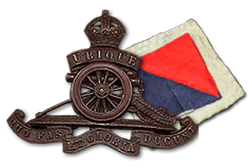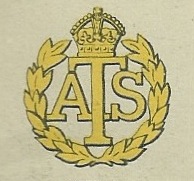The Berkshire Royal Horse Artillery was a Territorial Force Royal Horse Artillery battery that was formed in Berkshire in 1908. It saw active service during the First World War in the Middle East, notably at Aden and in particular in the Sinai and Palestine Campaign, from 1915 to 1918. A second line battery, 2/1st Berkshire RHA, served on the Western Front in 1917 and 1918 as part of an Army Field Artillery Brigade. After the Armistice, it was reconstituted as a Royal Field Artillery battery of the Territorial Army (TA), later being expanded into a full heavy anti-aircraft (HAA) regiment that served during World War II in the Battle of Britain and Blitz, in the assault landings in North Africa, Sicily and Italy. Postwar, it continued in the TA until 1968.
The 38th Light Anti-Aircraft Brigade was an air defence formation of Britain's Territorial Army formed just before World War II, which protected London and Southern England during the Blitz and later converted into an infantry formation for the liberation of Europe.
The 32nd (Midland) Anti-Aircraft Brigade was an air defence formation of Anti-Aircraft Command in Britain's Territorial Army (TA) from 1936 to 1955, charged with defending the East Midlands of England.
The 34th Anti-Aircraft Brigade was an air defence formation of Anti-Aircraft Command in the British Territorial Army formed shortly before the outbreak of World War II. It defended the West Midlands of England during The Blitz.
35th Anti-Aircraft Brigade was an air defence formation of Anti-Aircraft Command in the British Territorial Army (TA) formed shortly before the outbreak of World War II. It defended the important naval base of Portsmouth during The Blitz.

The 71st (Forth) Heavy Anti-Aircraft Regiment, Royal Artillery was an air defence unit of Britain's Territorial Army (TA) formed in Scotland just before World War II. It served in North Africa and Italy during the war. Its successors continue to serve in the Army Reserve as part of the Royal Logistics Corps.
The 41st (London) Anti-Aircraft Brigade was an air defence formation of Anti-Aircraft Command in the British Territorial Army, formed shortly before the outbreak of World War II. Its role was to defend East Anglia.
The 37th Anti-Aircraft Brigade was an air defence formation of Britain's Territorial Army (TA) formed just before the outbreak of World War II. It was engaged in defending the Thames Estuary during the war, and continued to form part of Anti-Aircraft Command in the postwar era.

The 113th Heavy Anti-Aircraft Regiment was an air defence unit of the British Army's Royal Artillery during World War II. It saw action during The Blitz, landed in Normandy on D-Day and served throughout the subsequent campaign in North West Europe, operating as medium artillery in the Battle of the Scheldt, Unusually, its AA guns were successfully used to destroy enemy submarines in the closing stages of the war.
The 86th Heavy Anti-Aircraft Regiment, Royal Artillery was an air defence unit of Britain's Territorial Army (TA) that served throughout World War II. It defended London during The Blitz, landed on Juno Beach on D-Day, and defended the cities of Belgium against V-1 flying bombs.

The 89th Heavy Anti-Aircraft Regiment, Royal Artillery was an air defence unit of Britain's Territorial Army (TA) raised in Kent just before the outbreak of World War II. It served during the Battle of Britain and defended the Suez Canal while batteries served in the Battle of Crete and the Siege of Tobruk. The regiment then fought through the North African and Italian campaigns.

175th Heavy Anti-Aircraft Regiment, Royal Artillery was an air defence unit of the British Army formed during World War II. It served in defence of the vital naval and air base at Gibraltar.

85th (Tees) Heavy Anti-Aircraft Regiment, Royal Artillery was a part-time unit of Britain's Territorial Army (TA) formed on Teesside just before the outbreak of World War II. Its service during the war included the Battle of France and Dunkirk evacuation, the Battle of Britain and Blitz, and the North African and Italian campaigns. It continued to serve in the air defence role until 1961.

91st Heavy Anti-Aircraft Regiment, Royal Artillery was a part-time unit of Britain's Territorial Army (TA) formed in the West Riding of Yorkshire just before the outbreak of World War II. Its service during the war included Home Defence during the Battle of Britain and The Blitz, and a length period in Middle East Forces. Postwar it continued to serve in the TA in the air defence role until 1955.
The 5th Anti-Aircraft Brigade was an air defence formation of the British Army during World War II. It was formed as a searchlight brigade to protect the British Expeditionary Force's bases just before the Battle of France. After the Dunkirk evacuation it was reformed as a conventional anti-aircraft (AA) brigade and served through the rest of the war in Anti-Aircraft Command, defending various parts of the United Kingdom against bombing raids and V-1 flying bombs. It continued to serve in the Regular Army during the early postwar years.
45th Anti-Aircraft Brigade was an air defence formation of Britain's Territorial Army (TA). Formed in 1938, it was responsible for protecting South Wales during World War II. It was reformed in the postwar TA under a new title, and continued until 1955.

155th (Mixed) Heavy Anti-Aircraft Regiment was an air defence unit of Britain's Royal Artillery formed during World War II. Around two-thirds of its personnel were women from the Auxiliary Territorial Service (ATS). After defending the West of Scotland and later London, the regiment was heavily engaged in Operation Diver against V-1 flying bombs, and later was deployed to Antwerp to carry out anti-Diver duties there in the closing stages of the war.

143rd Heavy Anti-Aircraft Regiment was an air defence unit of Britain's Royal Artillery formed during World War II. It started out as a 'Mixed' regiment with around two-thirds of its personnel being women from the Auxiliary Territorial Service (ATS). The regiment defended the West of England from 1942 to the end of the war when it moved to South East England. The regiment continued in the postwar British Army.

136th Heavy Anti-Aircraft Regiment was an air defence unit of Britain's Royal Artillery during World War II. It protected the UK against air attack as part of Anti-Aircraft Command, including the defence against V-1 flying bombs. It was disbanded at the end of the war.

98th Heavy Anti-Aircraft Regiment, Royal Artillery, was an air defence unit of Britain's Territorial Army (TA) formed in Gloucestershire during the period of international tension leading up to the outbreak of World War II. It defended aircraft factories during the Battle of Britain, then the city of Manchester during the Blitz. It later served in the campaign in North West Europe. The regiment continued in the postwar TA until amalgamated in 1955.






